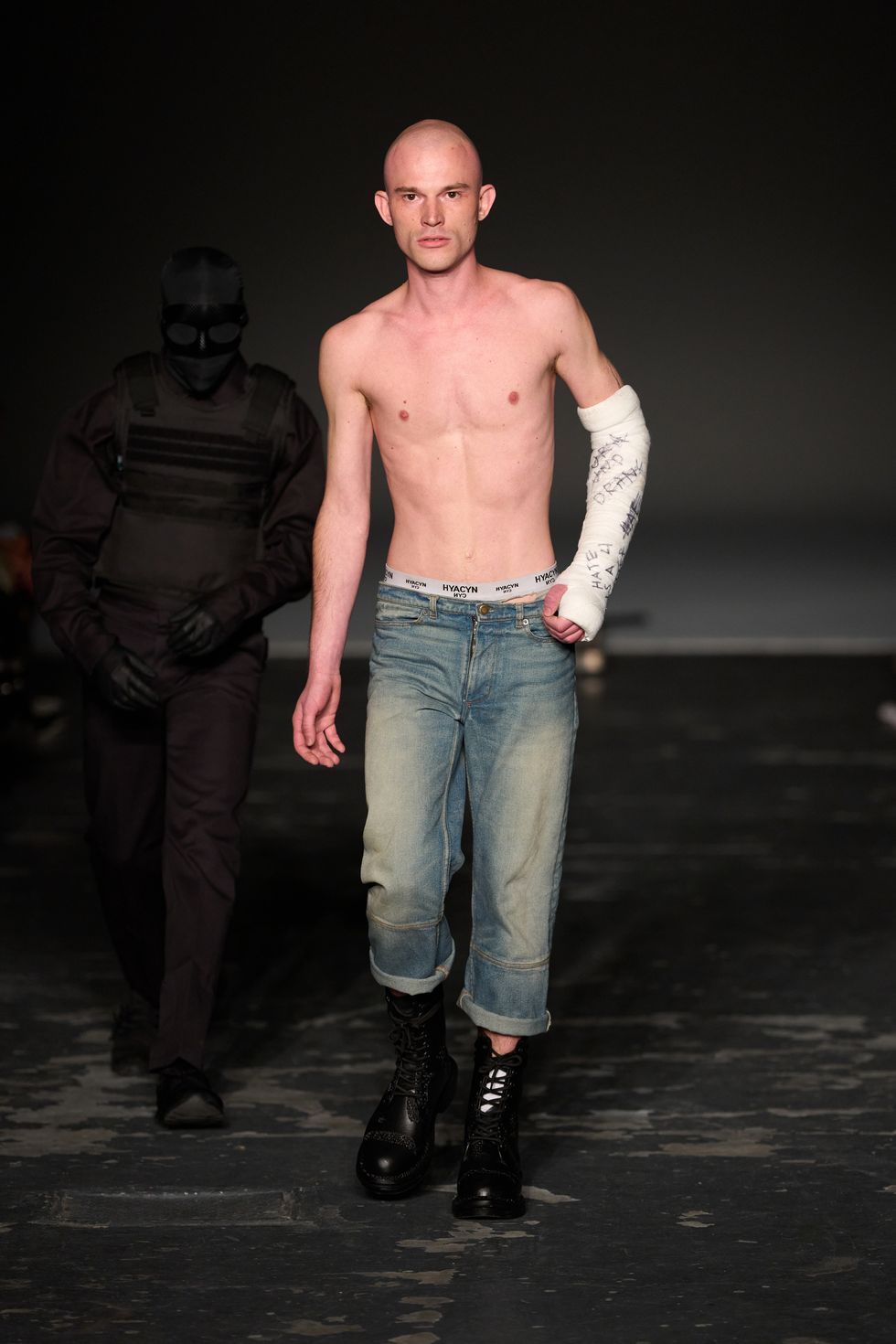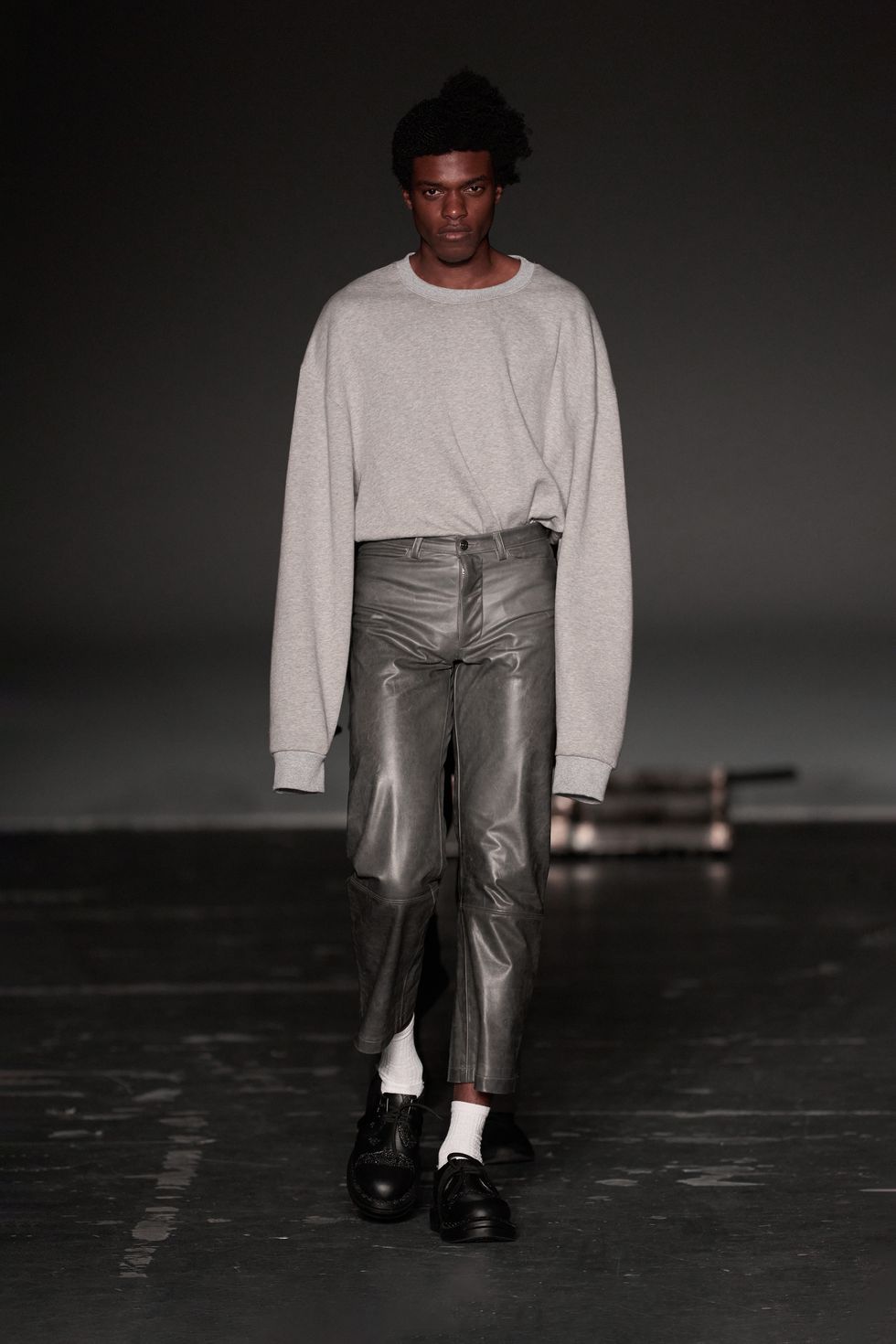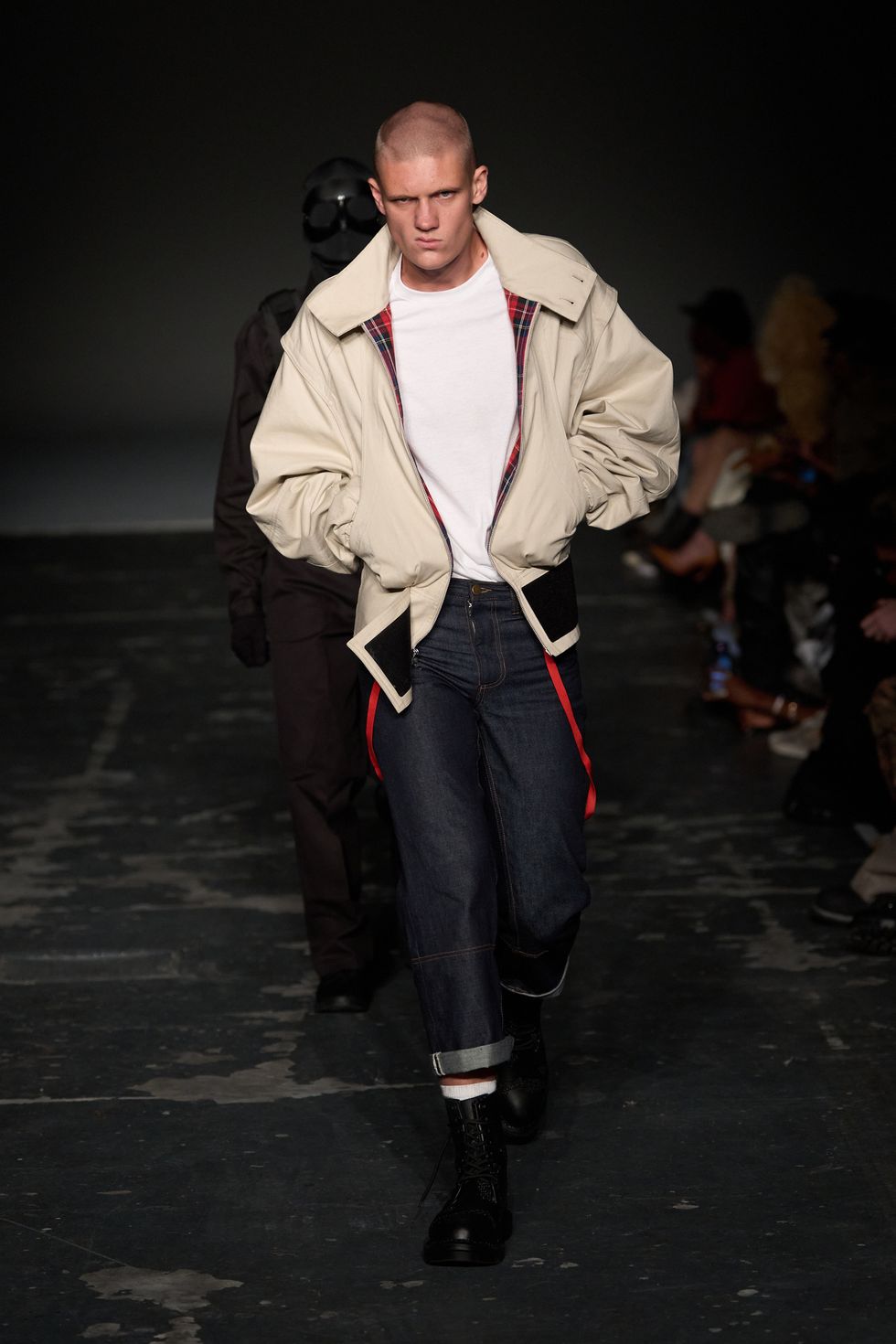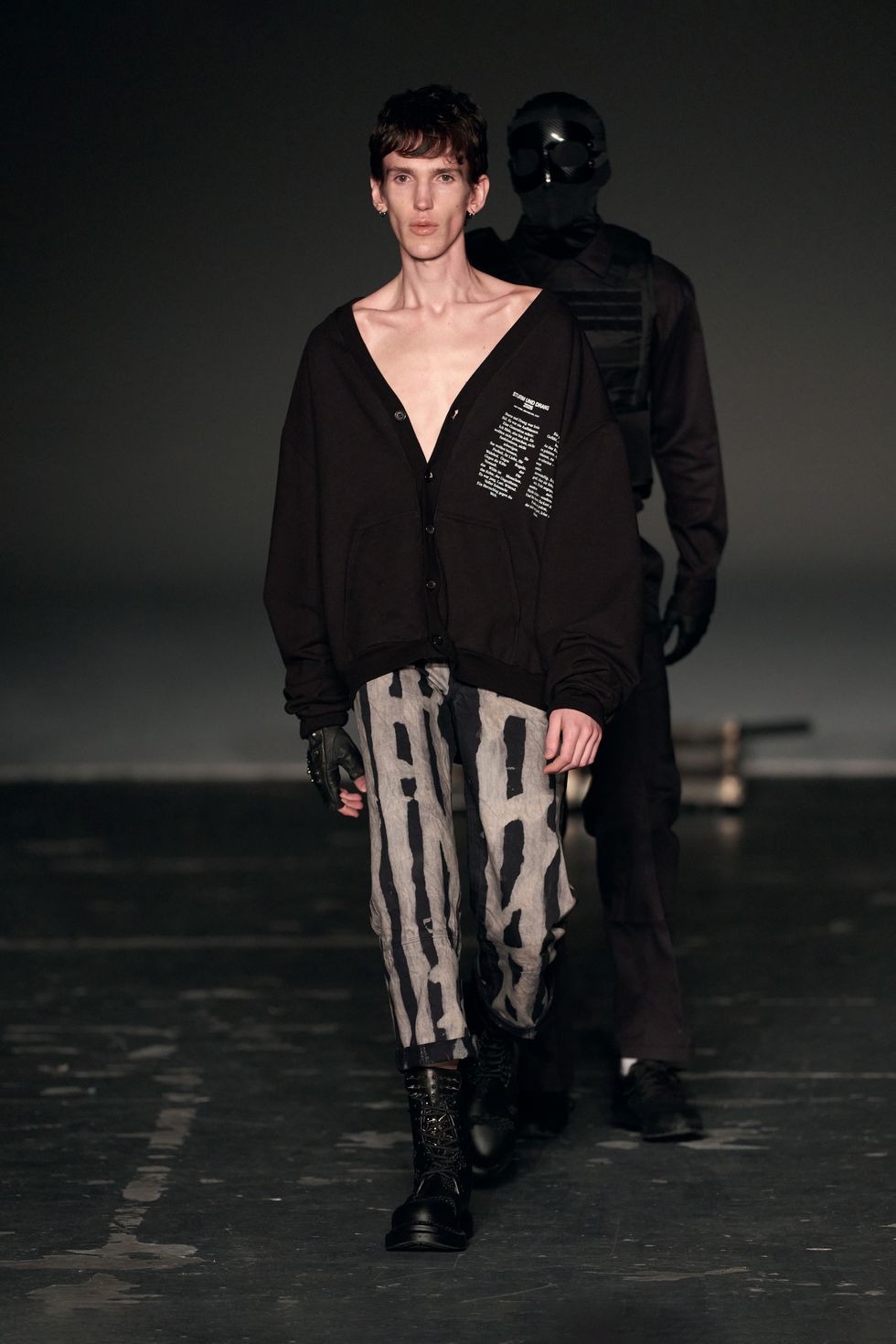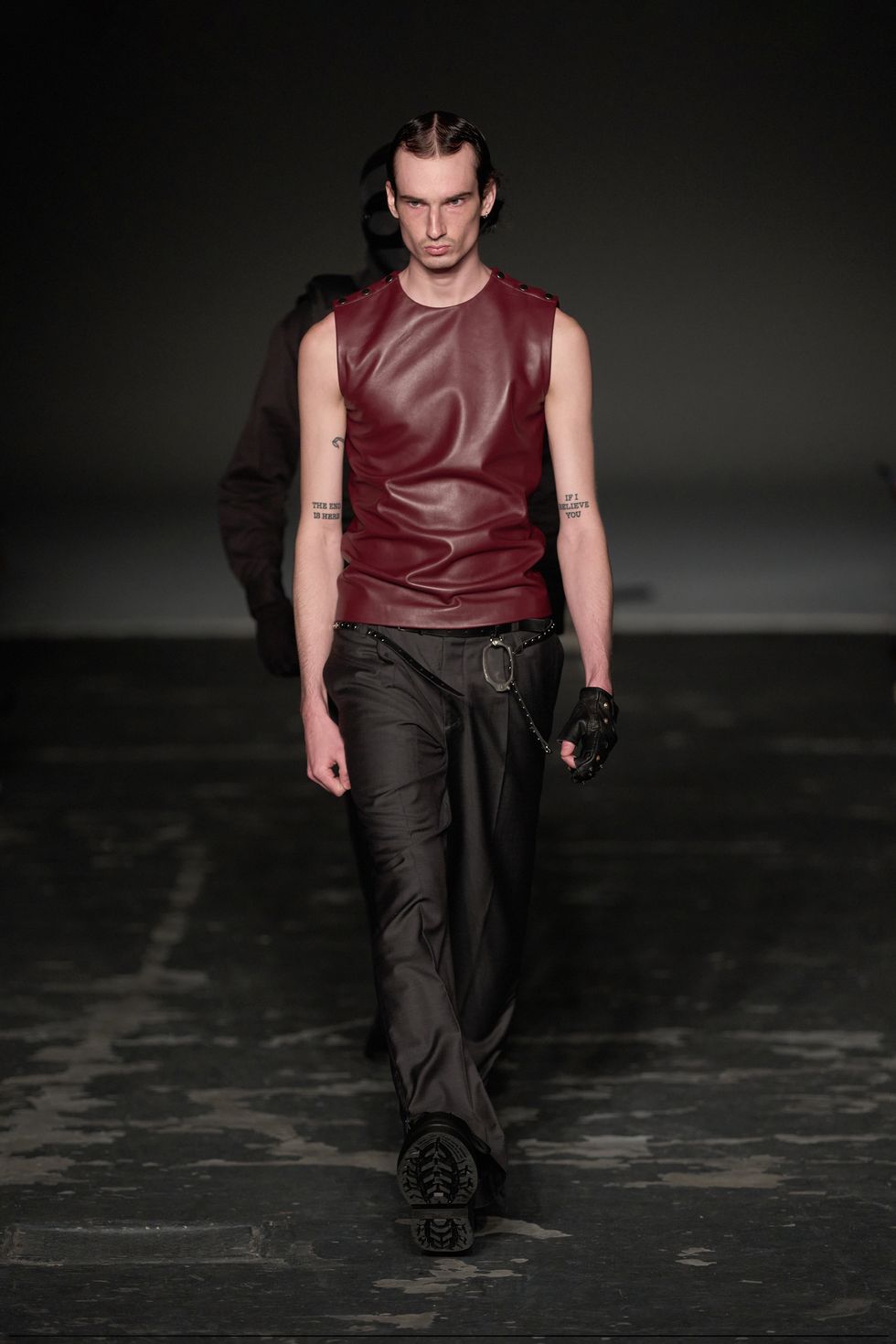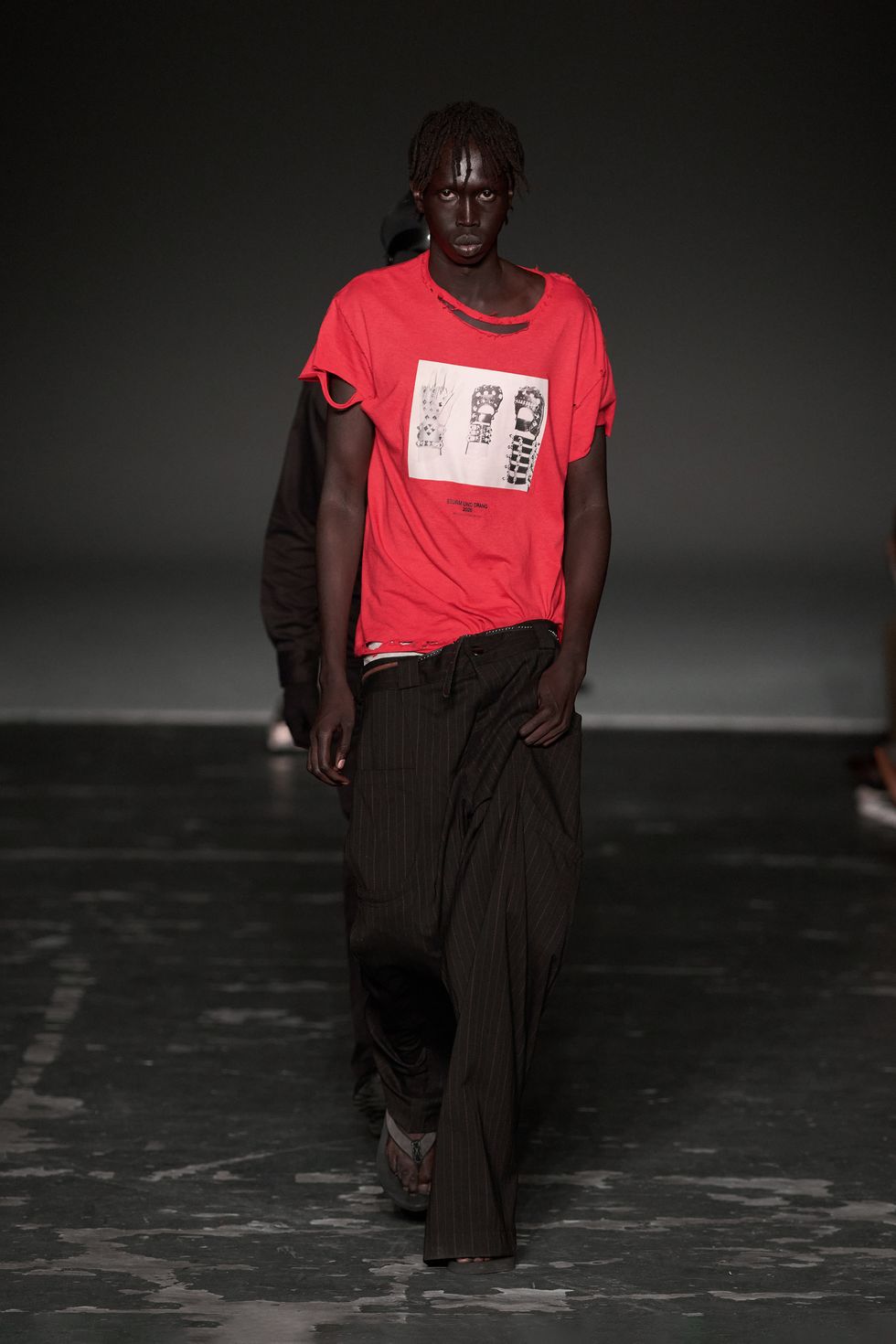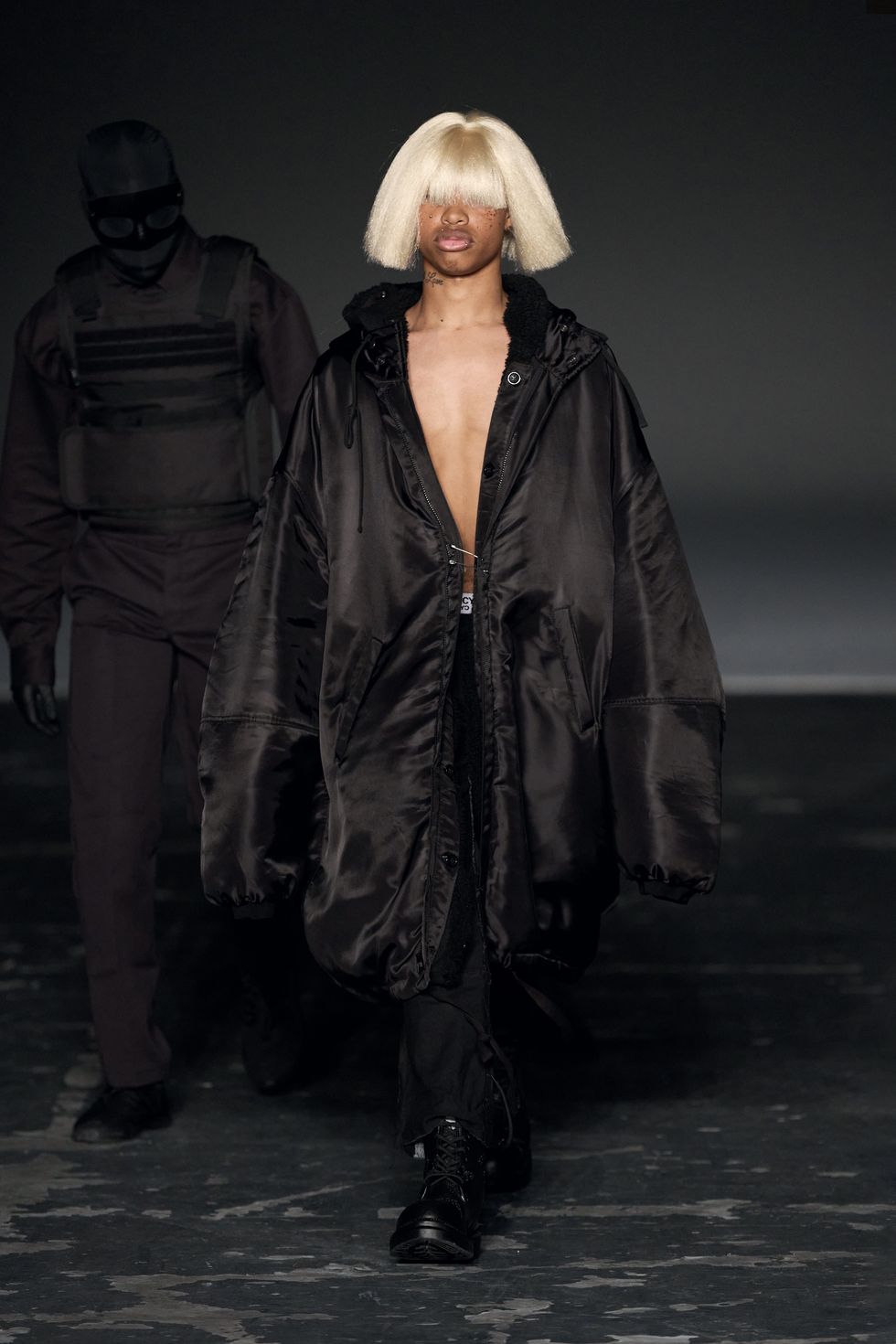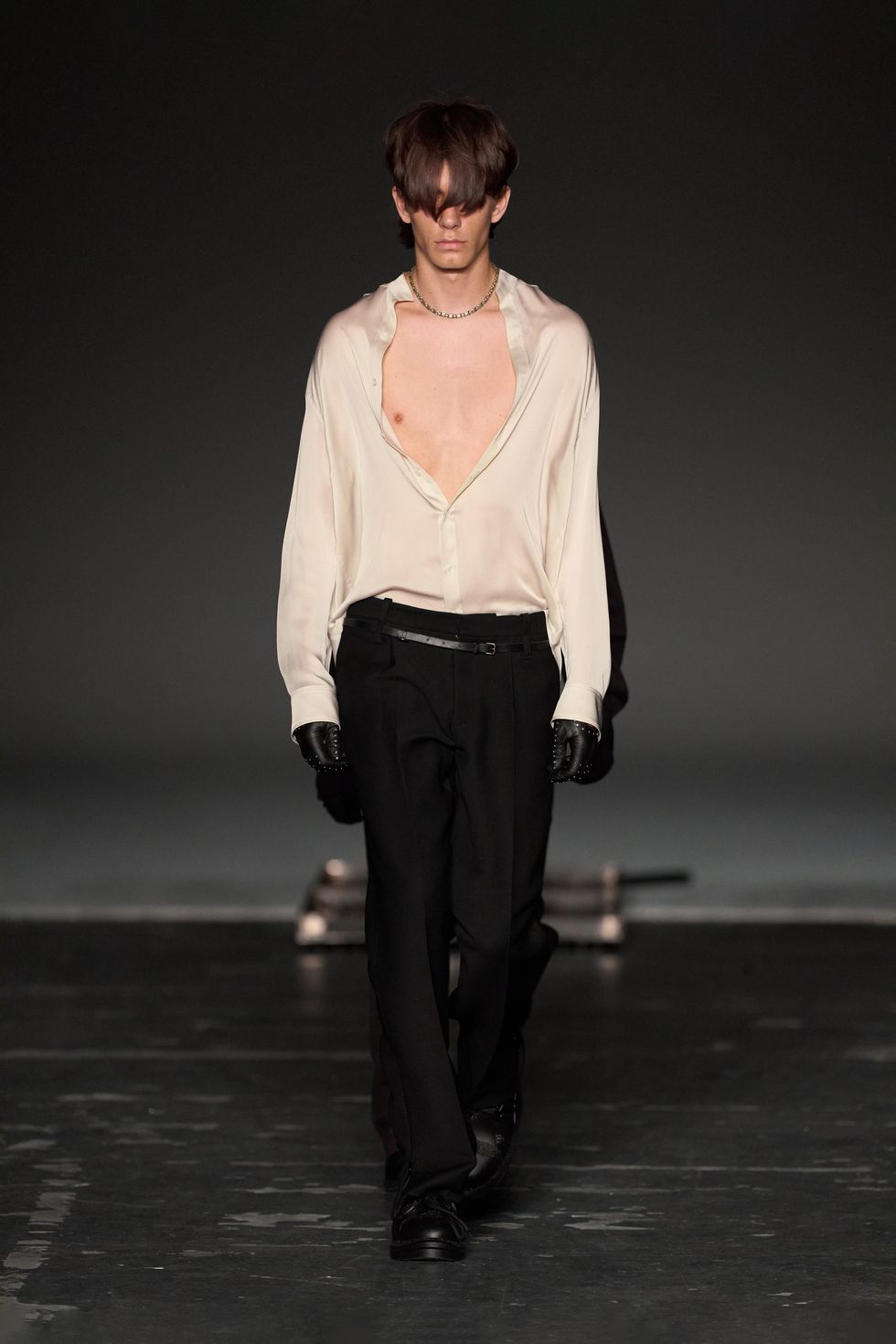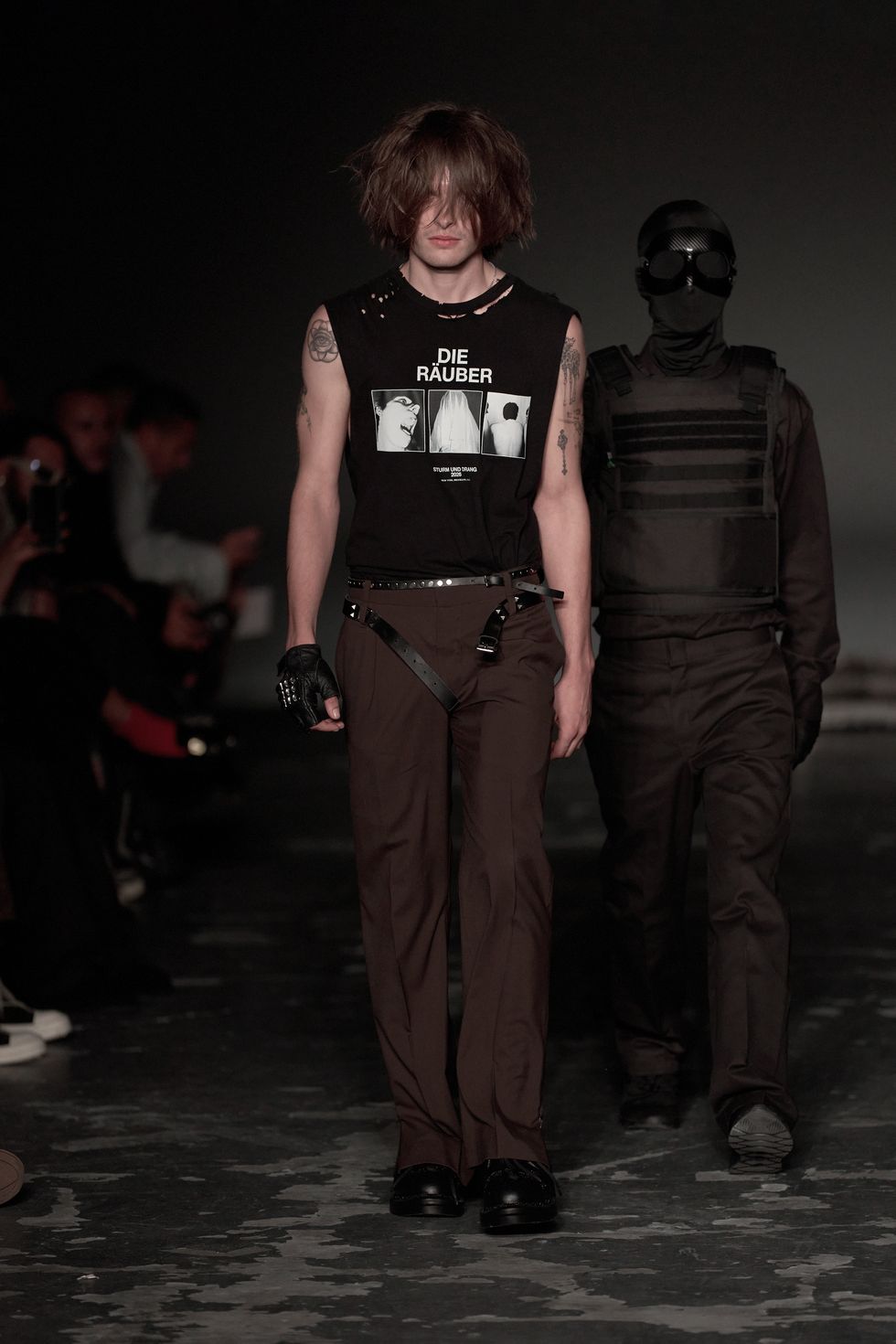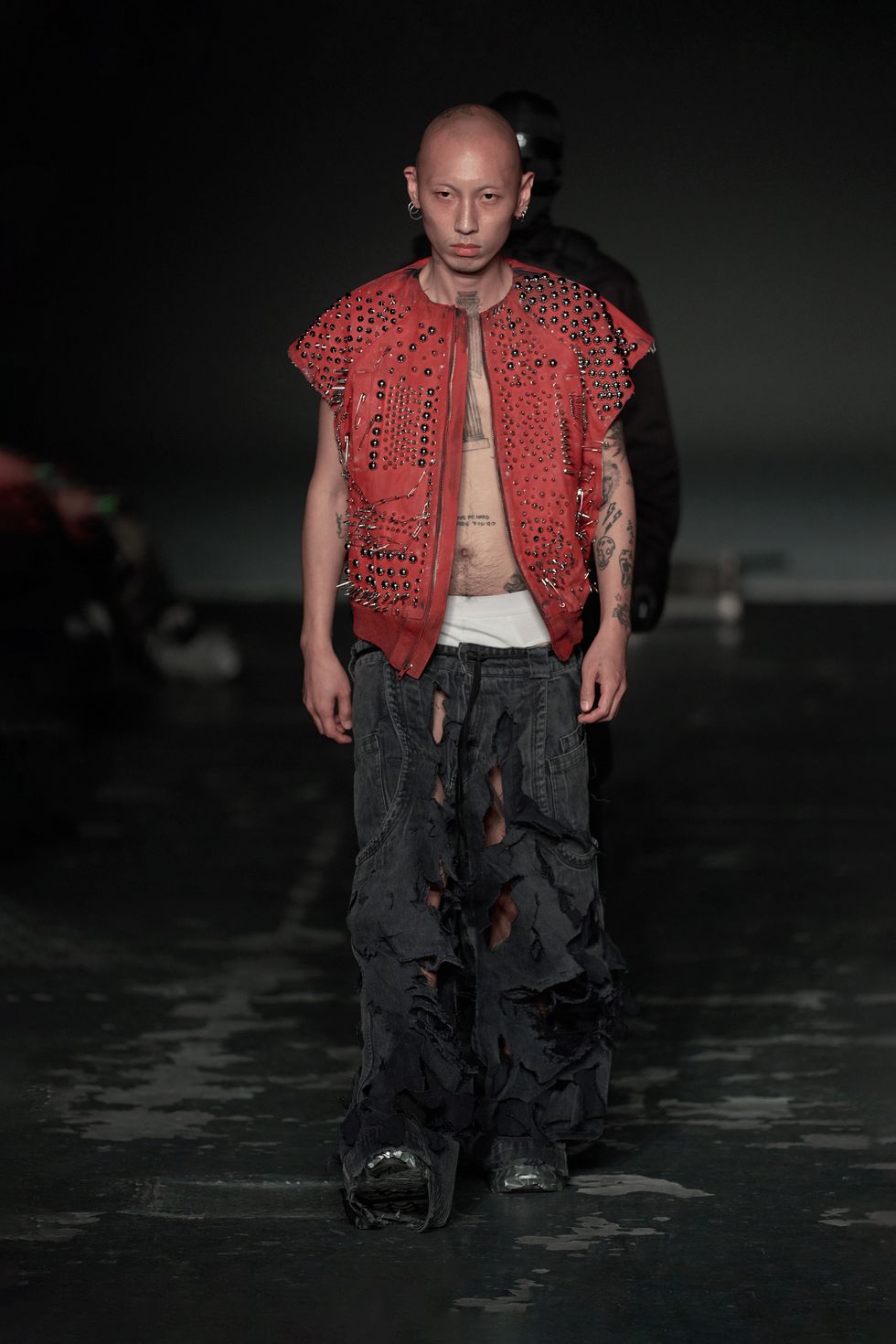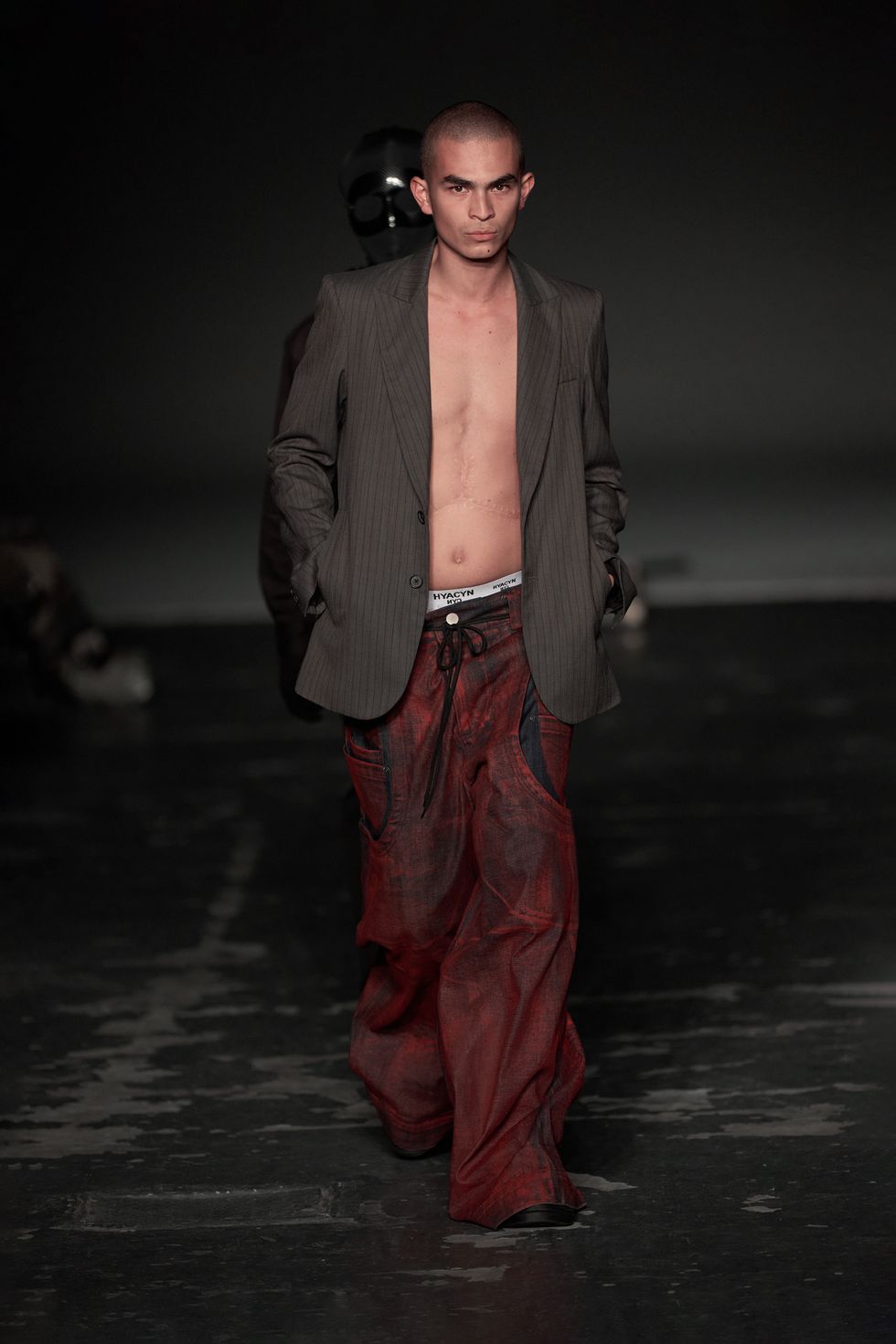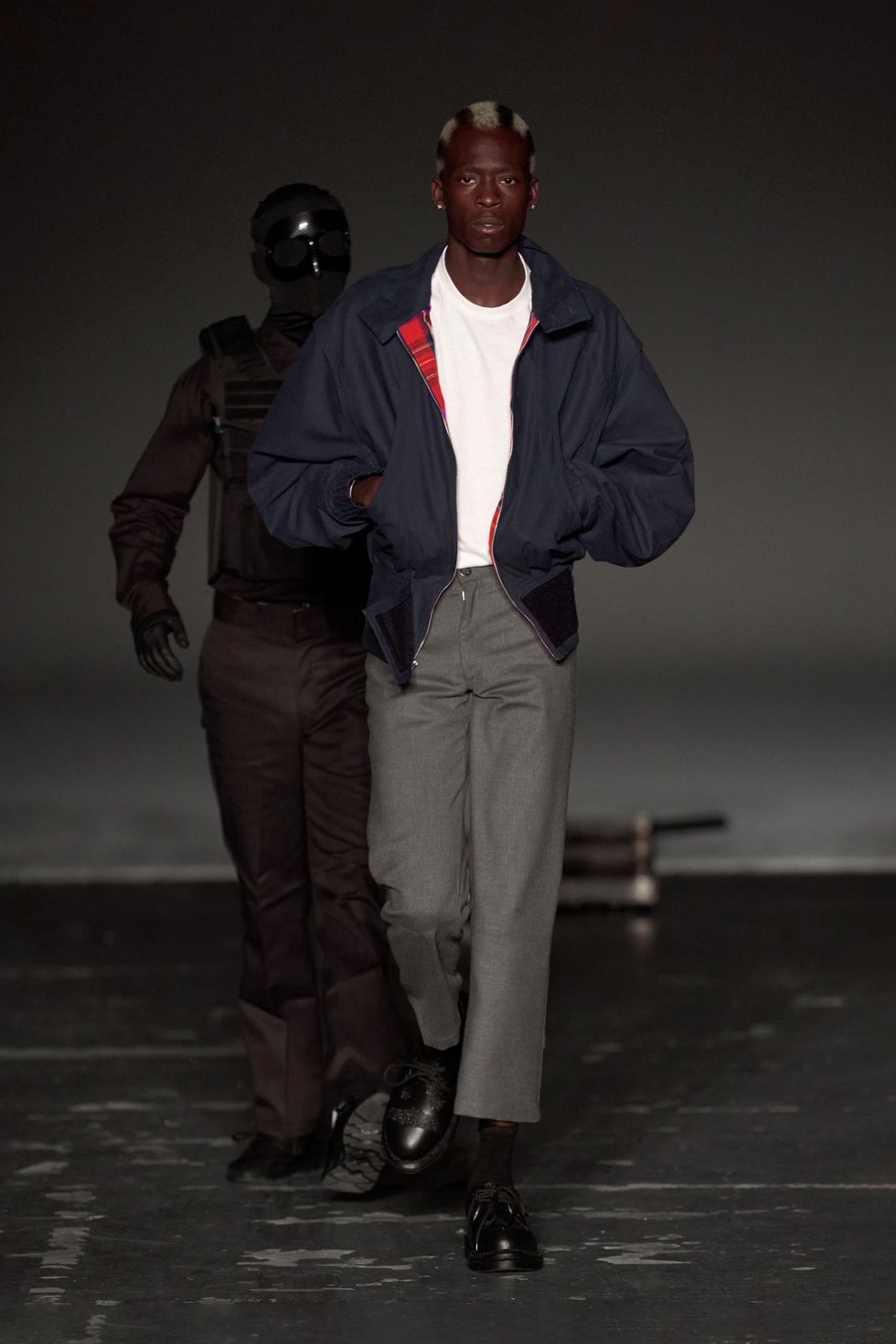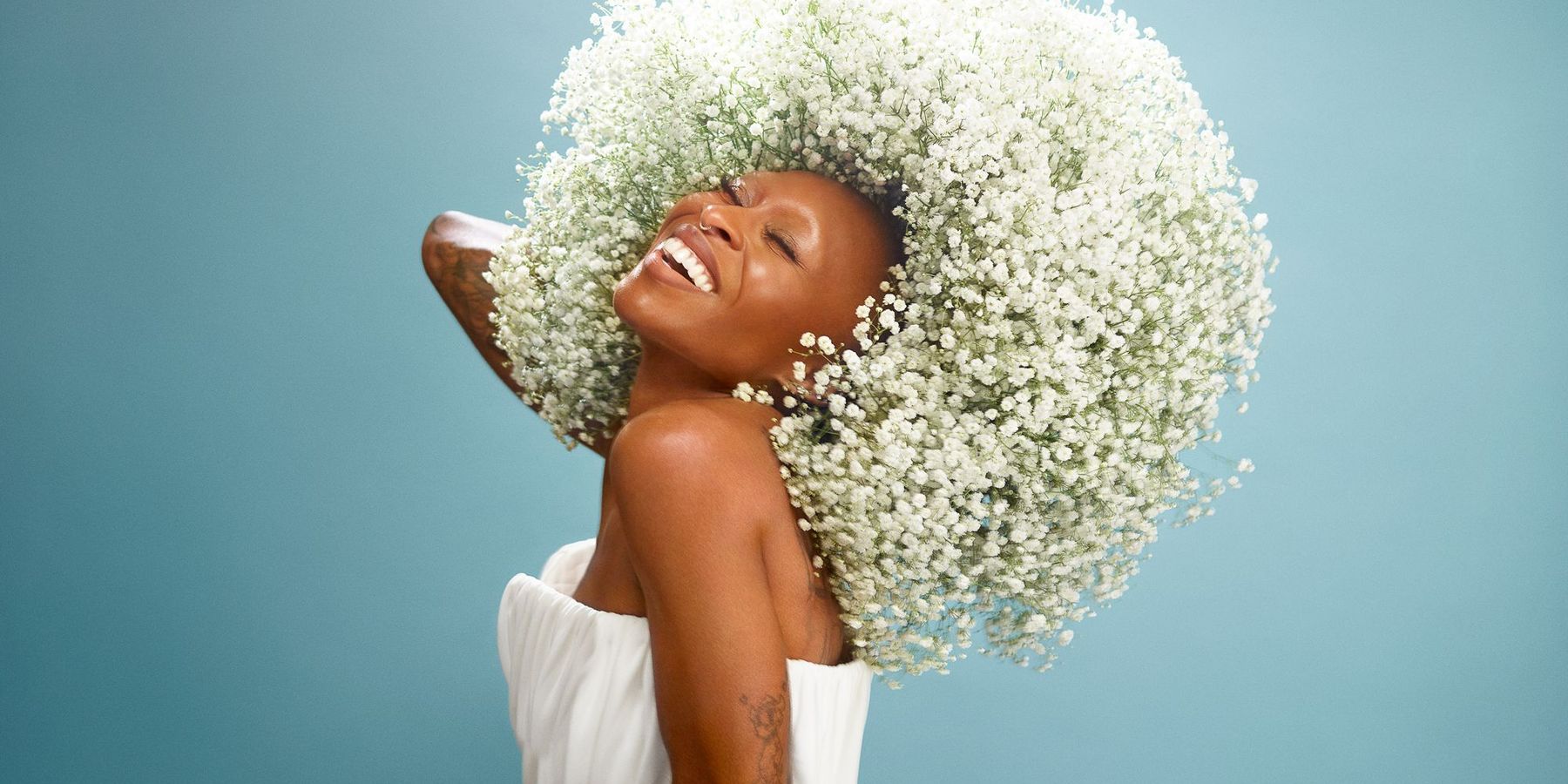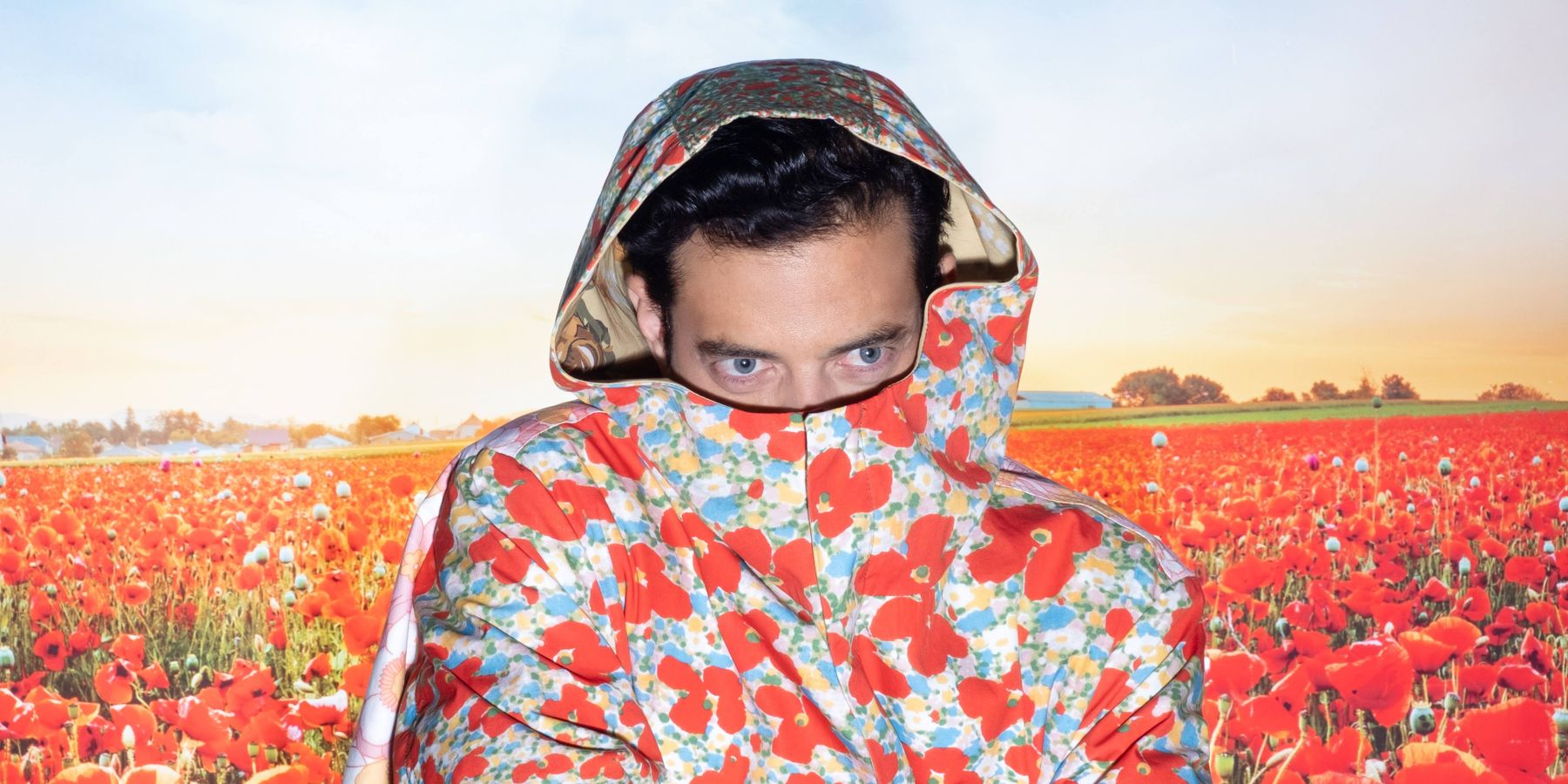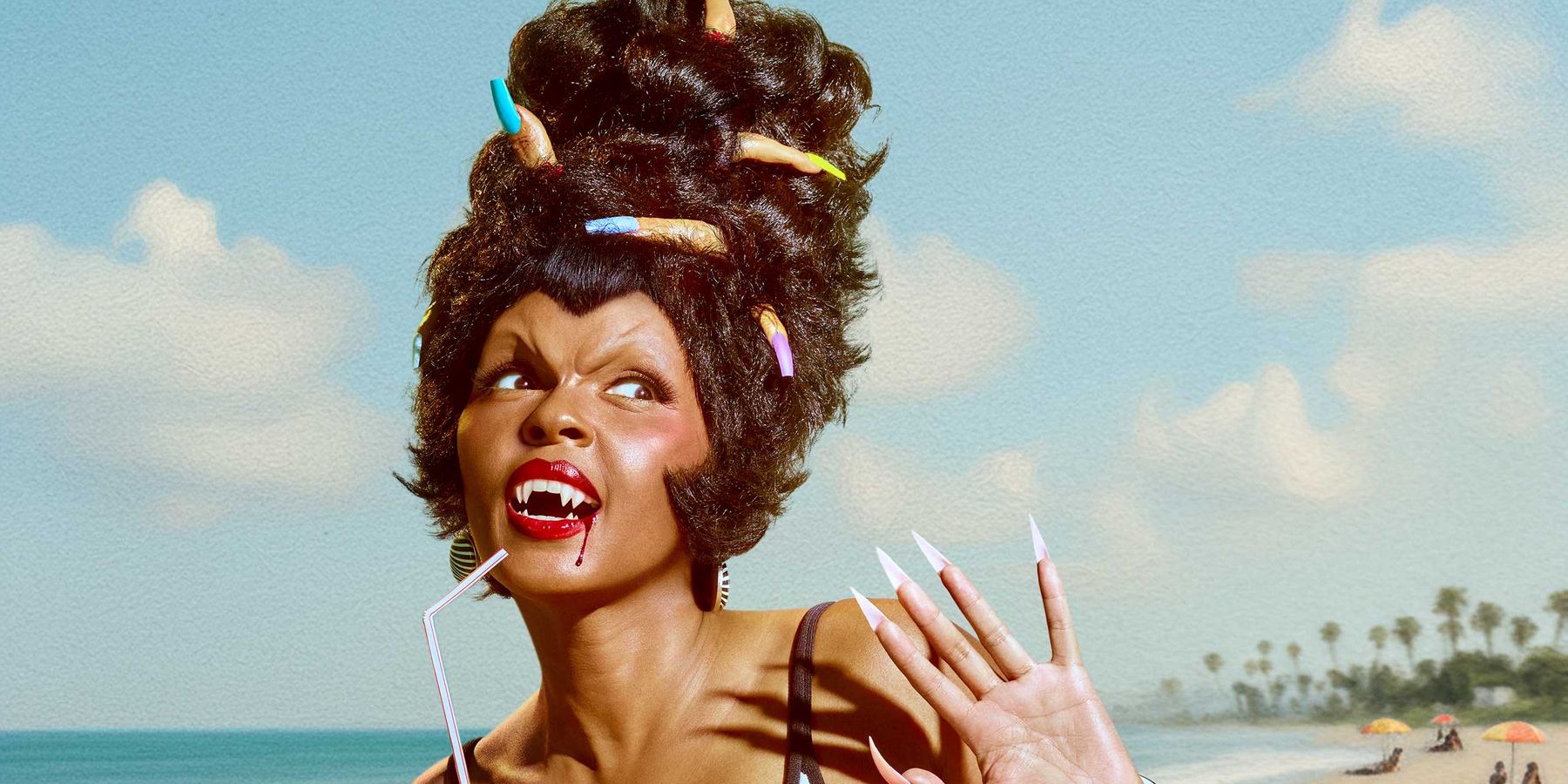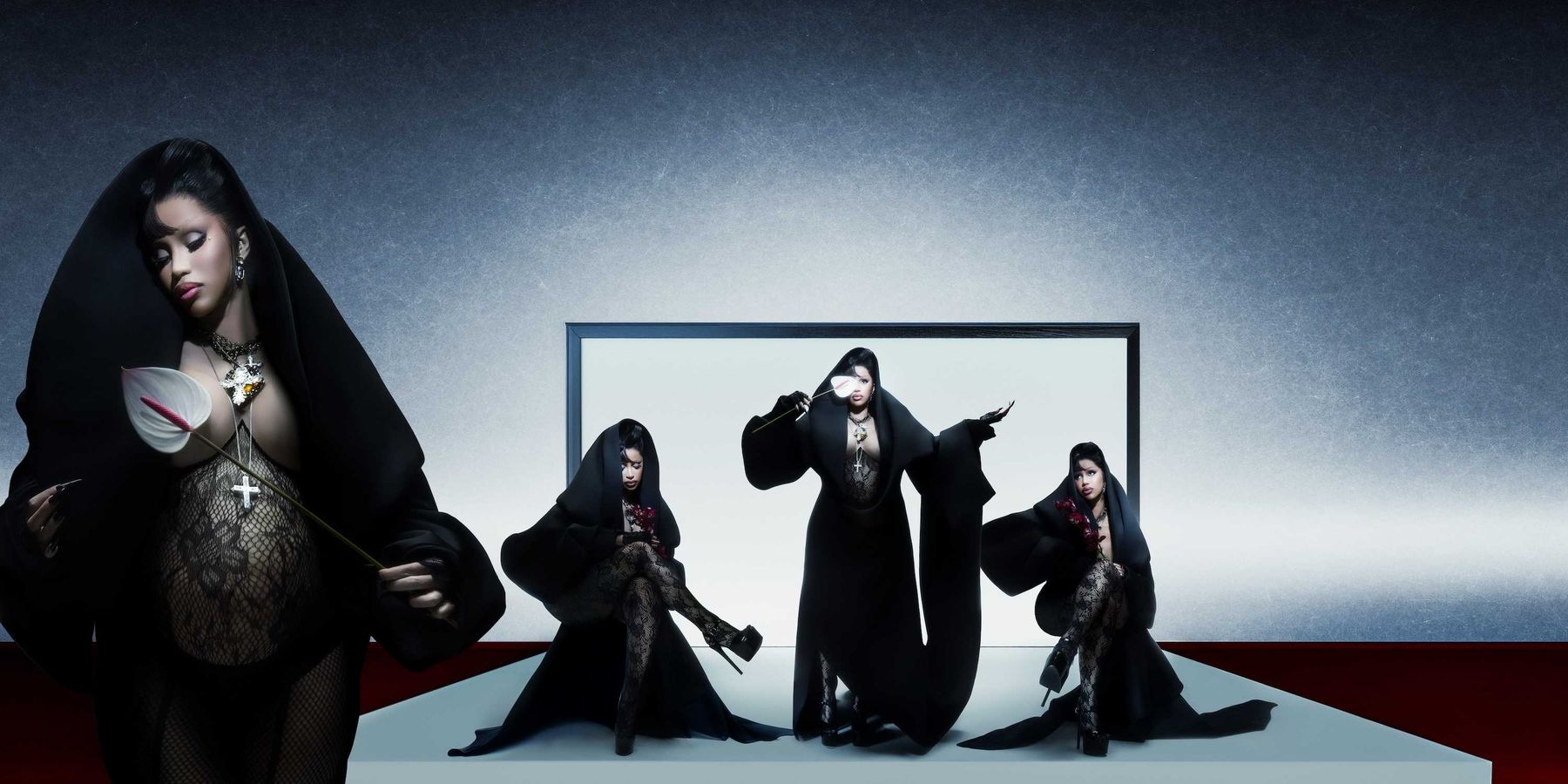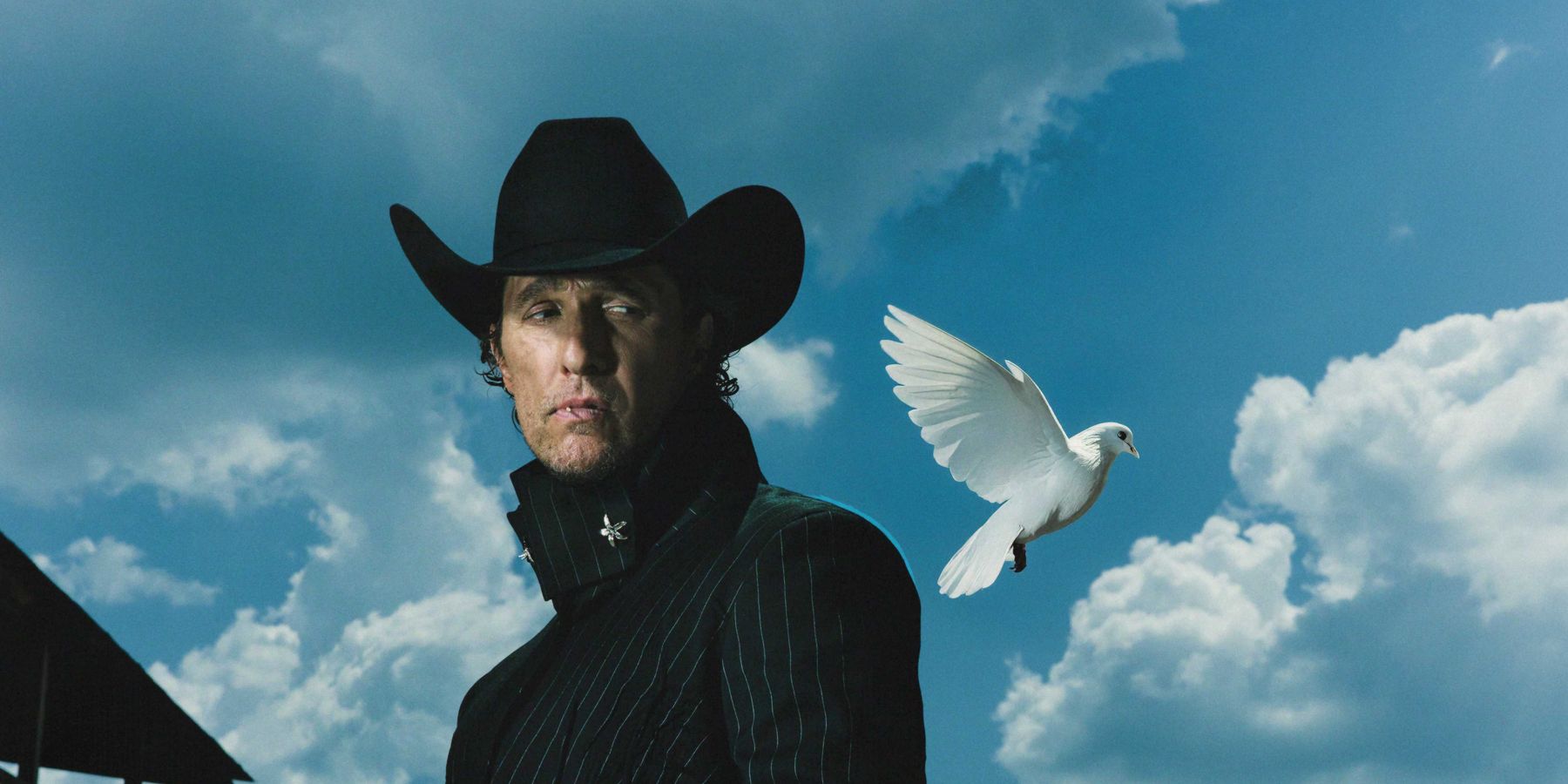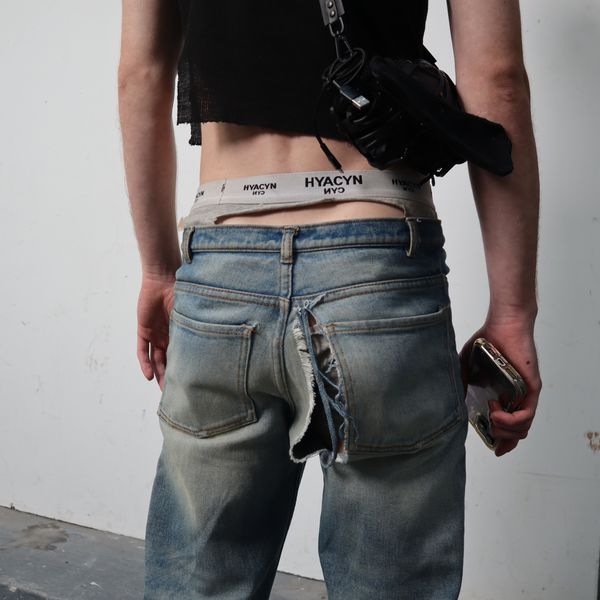
HYACYN Rejects Conformity
By Ivan Guzman
Sep 24, 2025For Tobias Ulmer, fashion is less about perfection than it is about honesty. “'Sturm und Drang' was about breaking from order and authority. That same defiant energy is what we want to capture — rejecting conformity while finding beauty in tension,” the HYACYN founder and creative director tells PAPER.
That ethos guided HYACYN’s latest collection, unveiled in Brooklyn during New York Fashion Week. Ulmer titled it "Sturm und Drang" after the 18th-century German literary movement that shaped his hometown and childhood. He remembers reading Friedrich Schiller in school and growing up surrounded by castles and history, where rebellion felt embedded in the landscape. For Ulmer, it became a lifelong question of authenticity: Who am I? Who are we? What are we doing here? The show staged those questions through clothes that swung between structure and collapse: strict leather tailoring offset by raw edges, fluid trousers dragging into heavy boots, distressed graphics scrawled across otherwise refined silhouettes.
Equally important was the staging. Where HYACYN once parked a truck inside a warehouse, this time the runway was stripped down to a single door installation by Bronx-based artist Isaiah Davis. Titled Intimacy, the piece became a metaphor for privacy and choice. “The door became my symbol of privacy — your home, your right to decide who comes in and out,” Ulmer says. For him, the door also embodied self-protection against outside forces that try to dictate identity. Fashion became the act of choosing who to let in.
The collection also marked HYACYN’s first foray into footwear, in collaboration with Italian label RAL. Together they unveiled 3D-printed boots — Derby, Midsize, and Top High — silhouettes that felt classic but reimagined with radical new construction. Much like the clothes, the shoes balanced heritage with future-facing innovation, a literal step into the brand’s next chapter.
The front row underscored HYACYN’s cultural reach: Bktherula, Rich Amiri, Destroy Lonely, Matt Ox, Honey Balenciaga and the Clermont Twins sat among a community that mirrors Ulmer’s world. He casts models not for their perfection but for their presence. “I’m not afraid of being myself, and that’s the energy I want to carry forward,” he says. That ethos resonated in a lineup of boys whose imperfect fits often made the looks stronger.
Six years after moving to New York, Ulmer still can’t quite believe how far HYACYN has come. “When someone comes to the show and it resonates with them, that gives me goosebumps,” he says. "Sturm und Drang" was a declaration: HYACYN isn’t just making clothes, but building a platform rooted in authenticity, collaboration, and the right to be yourself.
PAPER caught up with the designer to chat about his showstopping collection at NYFW and where HYACYN is headed next.
How are you, Tobias? How did the show go?
I think it went very well—better than I expected, to be honest. Usually when I do something, I set big goals for myself, but that doesn’t always mean it works. This time, though, it really did.
Tell me about the name Sturm und Drang. What drew you to that?
One of the important writers and poets of that movement, Friedrich Schiller, was born near my hometown. In school, we learned about the Sturm und Drang era — what it meant and where it started. My hometown also has one of the biggest castles you can still visit, so history was always present where I grew up. That rebellious movement was part of my environment from the beginning.
They weren’t only rebelling; they were asking, What is a human being? Why are we separated from others? What makes us different? These were very modern and intellectual thoughts for the time. That always stuck with me.
When I started this brand — when it became a brand — the most important thing for me was authenticity. Who am I? Who are we? What are we doing here? That movement’s way of questioning and trying to change society is something I admire and try to follow in my own life. So when I thought about this collection, the mental message I wanted to express was authenticity. I know it’s said often, but I really believe it: being yourself. That idea comes from my youth, from where I grew up—it feels like it’s in my DNA.
Can you talk about the door installation for the show?
Last season, our show featured a truck in a warehouse, inspired by Berlin in the early ’80s, when the city reclaimed its bunkers to host electronic parties. People took to the streets with loudspeakers on trucks, claiming, This is our culture. We want it back. That spirit eventually grew into the Love Parade. So in that case, the concept came from the location itself.
This time, I wanted the idea to come more from the behavior of the show. I wanted a clean space, something symbolic. I’ve always been inspired by modern opera stages—how they create entire worlds with limited means, without CGI, often in very minimalistic ways. I thought of Lars von Trier’s Dogville, where a single door or bed can stand in for an entire house. That use of imagination really resonated with me.
The door became my symbol of privacy — your home, your right to decide who comes in and out. I think that’s something we should all protect in life: the ability to choose who influences us, who we love, how we live. Then I met Isaiah Davis, who grew up in the Bronx. His life experience was very different from mine in Germany, but we connected immediately on this idea of autonomy. For him, as a Black man navigating identity and self-expression in the Bronx, it wasn’t always easy to just be himself. He understood the door concept right away and named the piece Intimacy, which I loved. Not everyone should have access to that door — it’s deeply personal.
When we closed the door during the show, for me it symbolized the outside world trying to dictate who we can be, what we can do. You see that happening again globally, with governments imposing restrictions. I don’t want to be too political — fashion is still fashion, a brand is still a brand — but it’s important that what we create carries meaning. Not just political meaning, but personal meaning too. That’s the authentic core of who I am, and of the people who work with me.
And how do you see this idea shaping your future collections? Where do you see it going next?
That’s a good question. For me, there are always two levels when I think about a collection. The first is the style level—what silhouettes, proportions, or ideas I believe are coming next in fashion. Baggy pants, skinny pants—it’s not about rebellion or philosophy, it’s just the evolution of style. I ask myself, ‘What do I want to wear in six months? What feels right to me?’ That’s a big influence.
Then there’s the mental level: authenticity, rebellion, being unafraid to be myself. I don’t seek to be different for the sake of it—I just fight to be who I am. My life has been full of quirks where people say, ‘No way you really did that,’ but I did, because that’s what I wanted. I’m not afraid of being myself, and that’s the energy I want to carry forward into the next collection.
I actually started the moodboard for it this morning. The mental message will stay the same — about who we are, what we’re doing, and being ourselves with an open mind for anyone who wants to join. On the style side, I want to dig deeper into my German DNA — especially early ’80s wave and techno music, which has always influenced me. What does that community mean to me? How can it shape the brand’s future? That’s something I want to explore.
But beyond clothing, I want to grow HYACYN slowly. My goal is to create a platform people can trust — something that brings in artists, musicians, and communities to collaborate. Meeting people around the world and saying, ‘This is so good, would you want to work together?’ That gives me goosebumps. Honestly, that’s more important to me than selling a thousand hoodies.
The casting was great. What was your vision for the type of boy you wanted to walk the show?
Authenticity. For me, it’s so important to feel that someone is truly themselves. You can sense it right away. If someone comes in trying to act like a “supermodel” or put on a rebellious performance, it feels forced. But then there are people who walk in with such a strong vibe, such a presence, that you immediately know they belong.
For example, some models apologized for being 5’10” instead of taller, but we told them, ‘That’s fine.’ Height doesn’t matter to us. Of course, not everyone fits into our sample sizes — I don’t even fit into all of them myself — but that’s not a problem. Imperfection can actually be more interesting.
One of my favorite moments was the very last casting. A model had dropped out last minute, and a friend suggested someone new. As soon as he walked in, I knew I wanted him in the Queen Parka. It was a bit too big for him, but on the runway it looked perfect. That’s what I love: when the look isn’t about perfection, but about the message and the feeling it carries.
You just know when you see them.
Exactly. You know that someone will bring the right vibe, even if everything isn’t perfect. That’s what a runway show should be — less about strict perfection and more about playing with looks, proportions, and messages. And of course, if someone wants to buy the parka, they can get it in their size. The runway is about creating a feeling.
Any final thoughts?
Thank you so much. I really appreciate it. For me, this journey in New York has been incredible. I came here six years ago, then the pandemic happened, and I never thought I’d end up doing something that connected me to people here in such a real way. When someone comes to the show and it resonates with them, that gives me goosebumps.
Of course, we need to make money to keep the business running, but the real goal is to create something meaningful in New York, to build community, and to push New York Fashion Week forward.
Photography: Nick Andri and courtesy of HYACYN
Related Articles Around the Web
MORE ON PAPER
Entertainment
Cynthia Erivo in Full Bloom
Photography by David LaChapelle / Story by Joan Summers / Styling by Jason Bolden / Makeup by Joanna Simkim / Nails by Shea Osei
Photography by David LaChapelle / Story by Joan Summers / Styling by Jason Bolden / Makeup by Joanna Simkim / Nails by Shea Osei
01 December
Entertainment
Rami Malek Is Certifiably Unserious
Story by Joan Summers / Photography by Adam Powell
Story by Joan Summers / Photography by Adam Powell
14 November
Music
Janelle Monáe, HalloQueen
Story by Ivan Guzman / Photography by Pol Kurucz/ Styling by Alexandra Mandelkorn/ Hair by Nikki Nelms/ Makeup by Sasha Glasser/ Nails by Juan Alvear/ Set design by Krystall Schott
Story by Ivan Guzman / Photography by Pol Kurucz/ Styling by Alexandra Mandelkorn/ Hair by Nikki Nelms/ Makeup by Sasha Glasser/ Nails by Juan Alvear/ Set design by Krystall Schott
27 October
Music
You Don’t Move Cardi B
Story by Erica Campbell / Photography by Jora Frantzis / Styling by Kollin Carter/ Hair by Tokyo Stylez/ Makeup by Erika LaPearl/ Nails by Coca Nguyen/ Set design by Allegra Peyton
Story by Erica Campbell / Photography by Jora Frantzis / Styling by Kollin Carter/ Hair by Tokyo Stylez/ Makeup by Erika LaPearl/ Nails by Coca Nguyen/ Set design by Allegra Peyton
14 October
Entertainment
Matthew McConaughey Found His Rhythm
Story by Joan Summers / Photography by Greg Swales / Styling by Angelina Cantu / Grooming by Kara Yoshimoto Bua
Story by Joan Summers / Photography by Greg Swales / Styling by Angelina Cantu / Grooming by Kara Yoshimoto Bua
30 September
